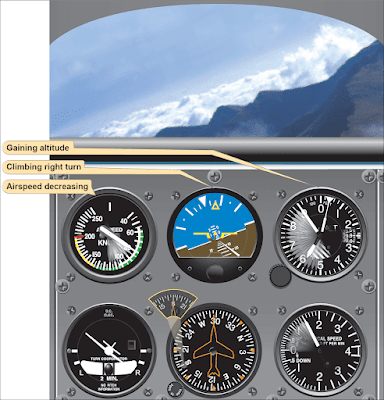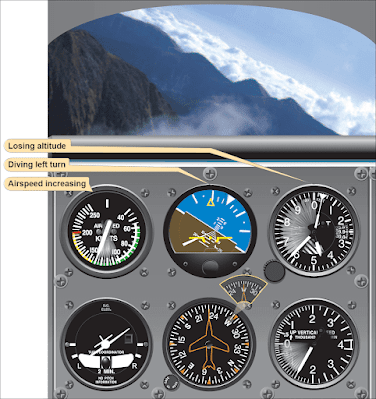An unusual attitude is an airplane attitude not normally required for instrument flight. Unusual attitudes may result from a number of conditions, such as turbulence, disorientation, instrument failure, confusion, preoccupation with flight deck duties, carelessness in cross-checking, errors in instrument interpretation, or lack of proficiency in aircraft control. Since unusual attitudes are not intentional maneuvers during instrument flight, except in training, they are often unexpected, and the reaction of an inexperienced or inadequately trained pilot to an unexpected abnormal flight attitude is usually instinctive rather than intelligent and deliberate. This individual reacts with abrupt muscular effort, which is purposeless and even hazardous in turbulent conditions, at excessive speeds, or at low altitudes. However, with practice, the techniques for rapid and safe recovery from unusual attitudes can be mastered.
When an unusual attitude is noted during the cross-check, the immediate problem is not how the airplane got there, but what it is doing and how to get it back to straight-and-level flight as quickly as possible.
Recognizing Unusual Attitudes
As a general rule, any time an instrument rate of movement or indication other than those associated with the basic instrument flight maneuvers is noted, assume an unusual attitude and increase the speed of cross-check to confirm the attitude, instrument error, or instrument malfunction.
Nose-high attitudes are shown by the rate and direction of movement of the altimeter needle, vertical speed needle, and airspeed needle, as well as the immediately recognizable indication of the attitude indicator (except in extreme attitudes). [Figure 1] Nose-low attitudes are shown by the same instruments, but in the opposite direction. [Figure 2]
 |
| Figure 1. Unusual attitude—nose-high |
 |
| Figure 2. Unusual attitude—nose-low |
Recovery from Unusual Attitudes
In moderate unusual attitudes, the pilot can normally reorient by establishing a level flight indication on the attitude indicator. However, the pilot should not depend on this instrument if the attitude indicator is the spillable type, because its upset limits may have been exceeded or it may have become inoperative due to mechanical malfunction. If it is the nonspillable-type instrument and is operating properly, errors up to 5 degrees of pitch-and-bank may result and its indications are very difficult to interpret in extreme attitudes. As soon as the unusual attitude is detected, the recommended recovery procedures stated in the POH/AFM should be initiated. If there are no recommended procedures stated in the POH/AFM, the recovery should be initiated by reference to the ASI, altimeter, VSI, and turn coordinator.
Nose-High Attitudes
If the airspeed is decreasing, or below the desired airspeed, increase power (as necessary in proportion to the observed deceleration), apply forward elevator pressure to lower the nose and prevent a stall, and correct the bank by applying coordinated aileron and rudder pressure to level the miniature aircraft and center the ball of the turn coordinator. The corrective control applications are made almost simultaneously, but in the sequence given above. A level pitch attitude is indicated by the reversal and stabilization of the ASI and altimeter needles. Straight coordinated flight is indicated by the level miniature aircraft and centered ball of the turn coordinator.
Nose-Low Attitudes
If the airspeed is increasing, or is above the desired airspeed, reduce power to prevent excessive airspeed and loss of altitude. Correct the bank attitude with coordinated aileron and rudder pressure to straight flight by referring to the turn coordinator. Raise the nose to level flight attitude by applying smooth back elevator pressure. All components of control should be changed simultaneously for a smooth, proficient recovery. However, during initial training a positive, confident recovery should be made by the numbers, in the sequence given above. A very important point to remember is that the instinctive reaction to a nose-down attitude is to pull back on the elevator control.
After initial control has been applied, continue with a fast cross-check for possible overcontrolling, since the necessary initial control pressures may be large. As the rate of movement of altimeter and ASI needles decreases, the attitude is approaching level flight. When the needles stop and reverse direction, the aircraft is passing through level flight. As the indications of the ASI, altimeter, and turn coordinator stabilize, incorporate the attitude indicator into the cross-check.
The attitude indicator and turn coordinator should be checked to determine bank attitude and then corrective aileron and rudder pressures should be applied. The ball should be centered. If it is not, skidding and slipping sensations can easily aggravate disorientation and retard recovery. If entering the unusual attitude from an assigned altitude (either by an instructor or by air traffic control (ATC) if operating under instrument flight rules (IFR)), return to the original altitude after stabilizing in straight-and-level flight.
Common Errors in Unusual Attitudes
Common errors associated with unusual attitudes include the following faults:
- Failure to keep the airplane properly trimmed. A flight deck interruption when holding pressures can easily lead to inadvertent entry into unusual attitudes.
- Disorganized flight deck. Hunting for charts, logs, computers, etc., can seriously distract attention from the instruments.
- Slow cross-check and fixations. The impulse is to stop and stare when noting an instrument discrepancy unless a pilot has trained enough to develop the skill required for immediate recognition.
- Attempting to recover by sensory sensations other than sight. The discussion of disorientation in Human Factors, indicates the importance of trusting the instruments.
- Failure to practice basic instrument skills. All of the errors noted in connection with basic instrument skills are aggravated during unusual attitude recoveries until the elementary skills have been mastered.
